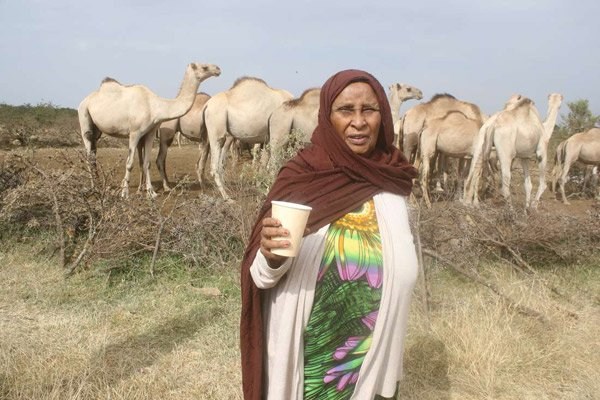
Friday January 19, 2018
By IRENE MUGO
In the light morning breeze, camels stick their heads out of acacia trees. Close by are calves separated from their mothers in an enclosure made of acacia branches.
The Seeds of Gold team is in Karionga village, a few kilometres from Nanyuki town, Laikipia County, to meet Halima Haji.
The 78-year-old woman rears camels for milk.
Her herd contains 62 dromedary camels which produce a maximum of between six to eight litres of milk each daily and four litres during the dry season.
“That one is from Turkana, the other is Pakistan and a majority of them are Somali,” Halima tells us as she takes us around the farm.
advertisements
In a good month she can earn a Sh1.2 million selling the milk at Sh80 per litre locally. The milk price can go up to sh100 to Sh150 in supermarkets.As we let the amount sink, Halima is already telling us how spot the different breeds based on height, shape and skin colour.
“The Turkana one is shorter and has a dark brownish colour while the Somali one is white and tall with the males having a broader face. I do not keep much of Pakistan camels because they are nomadic and easily get lost,” said Halima.
Halima started out with only six camels which she bought in Isiolo County at Sh15,000. Currently, one camel sells at between Sh150,000 and Sh200,000.
“I was interested in rearing the camels after learning of the health benefits of their milk,” she said.
Every morning before 8am when she visits the farm she has leased to graze the camels, she drinks three glasses of the raw milk.
Camel milk is said to be high in insulin which makes it suitable for diabetics, people suffering from arthritis and lactose intolerant children, among others.
Her daughters who have accompanied their mother to the grazing fields say camels are her true love.
“You have really made her day by coming here, she is very happy now,” said ZamZam Haji, Halima’s youngest daughter.
LESS FOOD AND WATER
The animals’ productivity largely depends on the seasons such that during the dry season the milk production per animal goes down compared to days rains are heavy and consistent.
Currently, the vegetation that germinated following the rains experienced in the last quarter of last year is diminishing and this is the worst season for the herders.
She hoping the dry spell will be assuaged semi-zero grazing system.
“The camels will definitely go out in the field to graze but I am planning that come back and graze somewhere together,” she said.
Halima is currently stocking up feeds for the animals to counteract the imminent drought as the weatherman predicts rains will begin in April.
The animals are going to be fed with bran and seed cake which will ensure they continue being productive despite the drought.
“We want the government to come up with a directive that will see companies manufacture feeds for camels just like there is for cattle and poultry,” said Halima.
Camels are replacing cows and goats in the pastoralist communities as choice livestock as the country continues to grapple with the vagaries of climate change.
According to Halima, camels can do with less food and water compared to livestock.
In her herd she has one male dromedary camel that helps in reproduction.
She said land shortage is the main hindrance to camel farming.
For instance she has leased a 300-acre piece of land to graze her camels at Sh20,000 per month.
They also rely on neighbours who partitions part of their land to allow the camels to graze at a fee of Sh500 per month.
Halima has previously had a herd of over 200 camels but lost a number to drought that took a toll on both humans and animals countrywide last year and to diseases.
REAR CAMELS FOR MILK
She has employed three men who take care of the animals and milk them.
“I only allow them to milk the camels once per day in the morning, the rest of the day the calves are left to feed,” she said.
John Oguk, an expert in camel farming, said the common diseases that affect camels are foot and mouth, lumpy skin disease and mastitis.
Dr Oguk says a camel’s hump consists of stored fat which the animal metabolises when food and water are scarce.
“When the camels use their stored fat in the hump, it will diminish but will refill once they eat or drink again,” said Dr Oguk.
Halima said she collaborates with the veterinary doctors in the county to ensure her animals are all well vaccinated and free of diseases.
Besides liaising with the county vets, she also ensures her camels are bathed with pesticides that ensure they are free of ticks and other harmful flies.
She sells her milk to WhiteGold milk processing company that pasteurises and packages the milk in Nanyuki.
The company that was opened last year buys milk from pastoralist communities as far as Isiolo, Marsabit and Wajir counties. It is seeking a to reach Mandera County this year.
Camels are not only used for milk. They also leather and meat products.
“We have used the camels for transport for long but I think it is time we used them to turn in a profit,” she said.
Halima is looking to bring women together to rear camel for milk.